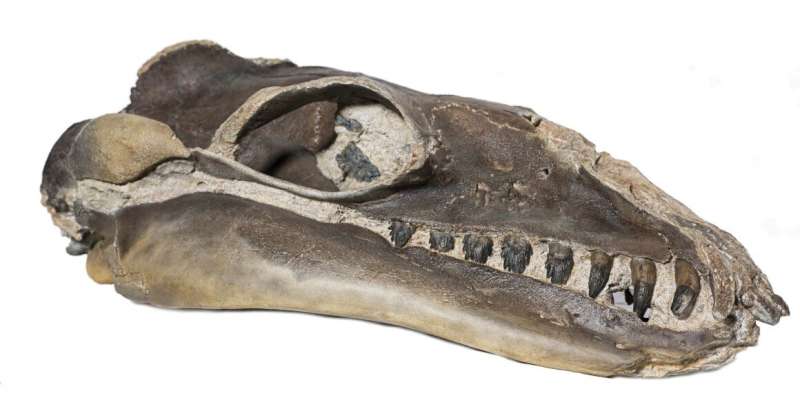This article has been reviewed according to Science X's editorial process and policies. Editors have highlighted the following attributes while ensuring the content's credibility:
fact-checked
peer-reviewed publication
trusted source
proofread
New research using fossils of whale ancestors reveals their path to becoming Earth's largest mammals

Modern cetaceans—whales and dolphins—have one of the largest size ranges of any living animal group, ranging from as small as 1.5 meters long to as much as 30. However, a new study reveals this diversity came much later in their evolution than expected.
To get a more detailed look at cetacean evolution, a team of scientists, including Dr. Travis Park and Dr. Gustavo Burin, both Leverhulme postdocs at the Natural History Museum, gathered body length measurements of 345 different species, including 89 living species and 256 fossil lineages, in the largest dataset of its kind. Their article, "The Dynamic adaptive landscape of cetacean body size" is published in Current Biology.
By comparing body lengths from both living and fossil species—an approach rarely taken—the research revealed that the evolutionary trends in cetacean size remained much the same for over 20 million years after they entered the ocean.
While whales of all sizes existed over this period, they were all evolving towards an optimum length of around 12.5 meters long, which is about the size of a humpback whale.
Co-lead author Dr. Gustavo Burin said, "While previous studies have looked at the evolution of cetacean body size, few had ever combined measurements from living and fossil species, and none was this comprehensive in terms of included species."
"The inclusion of fossils fills a lot of gaps in the evolution of these animals, showing that the patterns of evolution in body size are much less obvious than expected. This is an interesting finding that shows the limitations of excluding extinct species from studies of evolutionary trends."
After a shift towards evolving larger sizes early in their evolution, this trend remained constant for millions of years. A second shift occurred around 30 million years ago, as the ancestors of modern dolphins adapted to become fast-moving, agile predators.
The most extreme size adaptations, however, only take place in individual branches of the cetacean family much closer to the present. For instance, the average size of the ancestor of baleen whales increased by as much as 175%.
The researchers observed the changes by visualizing them as adaptive landscapes, where evolution is seen as a series of peaks and troughs. The best characteristics in a given environment are represented as peaks, and the taller they are, the more of an advantage they provide.
The team found that when fossil cetaceans were included with living species, the body size peaks disappeared. Instead, they found that the adaptive landscape was mostly flat, with few peaks.
The first cetaceans were goat-sized animals which lived on the edge of lakes and rivers, spending time both in and out of water. Over time, their descendants became increasingly adapted to life in water, before leaving land behind altogether.
Species which return to the water after living on land are known as secondarily aquatic, and in addition to cetaceans include animals such as penguins and crocodiles.
These species face a unique set of challenges after moving into the water, and evolving to become bigger in size is one way to solve many of them.
Dr. Travis Park, co-lead author of the paper, said, "Many lineages which return to the water tend to increase in size soon after making this transition, as it is often an advantage. For example, small species lose heat rapidly underwater, so getting large can help to maintain body temperature."
"Returning to the water might also release evolutionary constraints imposed by forces such as gravity, which would allow much larger body sizes to develop. It's difficult to say which is the most prominent cause, as body size is decided by a range of different factors all acting together."
For example, the minke whale, the smallest baleen whale, experienced a general decline in size. It's been suggested recently that this may allow the species to target smaller and more maneuverable patches of krill at night, when other whales aren't as active.
Over a third of all the skull measurements used in the paper came from Natural History Museum specimens, and total length data for 1,659 individuals retrieved from the NHM cetacean strandings database, demonstrating the importance of museum collections and research.
Going forward, the team of scientists responsible for this latest research want to apply a similar approach to other secondarily aquatic animals, with seals next to be looked at. Over time, they hope to see how these groups changed, and how competition between them could have affected their mutual evolution.
More information: Gustavo Burin et al, The dynamic adaptive landscape of cetacean body size, Current Biology (2023). DOI: 10.1016/j.cub.2023.03.014
Journal information: Current Biology
Provided by Natural History Museum
This story is republished courtesy of Natural History Museum. Read the original story here





















